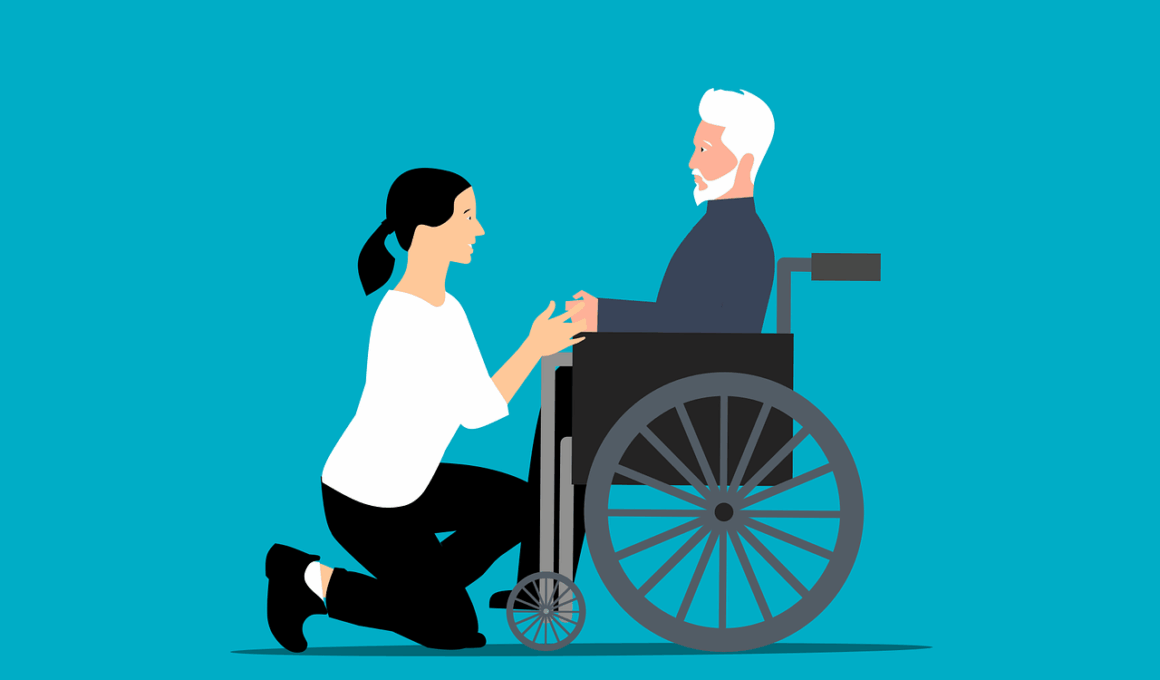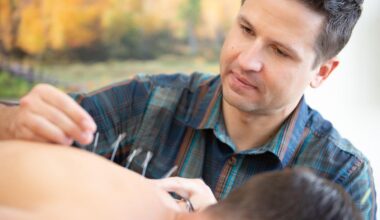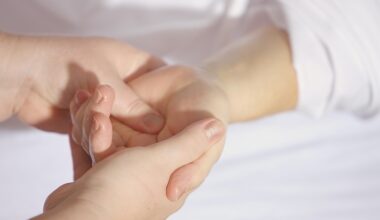How to Monitor Progress in Senior Mobility Recovery Post-Surgery
Monitoring progress in mobility recovery for seniors after surgery is essential for optimal healing. To begin, it’s vital to assess their starting point. This involves understanding their baseline mobility abilities, such as walking distance or range of motion. For comprehensive tracking, consider implementing weekly assessments. Document changes meticulously by recording physical capabilities over time. You may also use simple scales to gauge pain levels or comfortability during movement. Create a structured plan featuring targeted exercises focused on improving mobility. These exercises should include both flexibility and strength training tailored to the individual’s limitations. Ensure that caregivers and family members participate in this issue, as they can offer valuable observations. Additionally, utilize technology like smartphone applications or fitness trackers to establish accountability. Engaging seniors in their recovery fosters motivation and encourages adherence to exercises and set goals. It’s also beneficial to incorporate regular communication with healthcare providers to ensure safety and facilitate necessary adjustments in exercise routines. This extensive monitoring approach combined with personalized care will significantly enhance recovery experience and outcomes for seniors after surgery.
Tracking tangible results in mobility improvements is crucial for seniors recovering post-surgery. Keeping a journal can significantly aid this process. Encourage seniors to write about their daily experiences, detailing pain levels and achievement of mobility tasks. Implementing a checklist can also help identify daily goals, such as standing up from a chair without assistance or walking a certain distance. Regular physical therapy sessions can greatly enhance recovery, allowing professionals to guide and correct movements, ensuring safety. Incorporate feedback from therapists into the individual’s recovery plan, responding promptly to any reported issues. Additionally, creating a supportive exercise routine with family members fosters a sense of community while promoting regular check-ins. Alongside physical movement, focusing on nutrition also plays a vital role in recovery. Encourage a balanced diet rich in proteins, vitamins, and minerals to support healing. Regular hydration is essential; seniors should be reminded to drink ample water throughout the day. In this regard, develop a tracking system for fluid intake as well. Balancing emotional and physical recovery creates a comprehensive healing process and ultimately shapes successful mobility recovery for seniors post-surgery.
Emotional Support and Recovery Monitoring
Providing emotional support during recovery is just as essential as physical rehabilitation. Seniors may experience frustration or anxiety regarding their mobility, making emotional check-ins significant. Establish a regular communication channel with the senior, fostering an open dialogue about their feelings and challenges. Utilize positive reinforcement to celebrate small victories, encouraging their progress. Additionally, consider joining local support groups where seniors can share their experiences with peers who understand their situations. These gatherings can significantly boost morale and provide a sense of belonging. Encourage family visits and involvement in their recovery process, bringing companionship and familiarity, which often positively influences healing. Alongside emotional support, engaging in mindfulness practices like meditation can assist in reducing anxiety levels. You may suggest simple breathing exercises, which have proven effective in grounding individuals during overwhelming moments. Acknowledging behavioral signals indicating distress can allow caregivers to address concerns proactively. If necessary, consult mental health professionals who specialize in rehabilitative care for further assistance. This holistic approach ensures that emotional wellness is prioritized alongside physical recovery, ultimately fostering an encouraging atmosphere for seniors enhancing their mobility post-surgery.
Measuring improvements in mobility recovery can also be achieved through regular exercise testing. Utilize simple assessment methods like timed walking tests or sit-to-stand evaluations to quantify progress effectively. This statistical aspect provides tangible evidence of recovery, motivating seniors by highlighting their achievements. Use this data to adjust exercise regimens as recovery advances, introducing new challenges to stimulate growth. Additionally, slowly incorporating activities such as chair yoga or aquatic therapy can diversify routines, making them enjoyable while still beneficial. Diversifying also combats burnout and promotes engagement, keeping seniors excited about their journey. Remember that patience is essential; recovery timelines can vary greatly among individuals, making it important to respect personal goals and limitations. Establishing realistic milestones can guide expectations and prevent frustration. Consistent review of goals and milestones can greatly enhance the recovery environment by keeping it dynamic. Remind seniors that minor setbacks are often a natural aspect of the recovery process, and perseverance is key. Celebrating each accomplished goal, regardless of size, nurtures a positive mindset that will encourage continued progress toward improved mobility after surgery. This proactive striving for small wins is crucial in boosting their confidence as they heal.
The Role of Health Professionals in Recovery
Collaboration among healthcare professionals plays an invaluable role in enhancing mobility recovery for seniors. After surgery, maintaining close contact with doctors and physiotherapists ensures the monitoring of health outcomes throughout the rehabilitation journey. Schedule regular follow-up visits to assess progress and embrace adjustments to therapeutic strategies as needed. Physical therapists can develop personalized exercise protocols that focus specifically on the individual’s needs and limitations. They can also implement various techniques, such as manual therapy and proprioceptive training, to enhance mobility. Encourage open dialogues with health professionals to communicate any discomfort experienced during recovery. Addressing concerns promptly ensures safety and can lead to timely modifications to the rehabilitation plan. Additionally, nutritionists can offer tailored meal plans that support recovery following surgery, integrating essential vitamins and minerals into the diet. This nutritional guidance can result in fewer complications and faster healing times. Furthermore, creating a well-rounded care team, involving occupational therapists, can assist in daily activities that require enhanced mobility. This collaborative approach brings a collective focus on the patient’s overall well-being, thus fostering significant improvements throughout the recovery transition for seniors.
Incorporating assistive devices can significantly improve mobility recovery outcomes for seniors after surgery. Evaluate the necessity of tools such as walkers, canes, or braces to provide stability while regaining strength and balance. These devices should not be seen as signs of weakness; rather, they facilitate independence during rehabilitation. Engaging professionals to ensure proper fitting and education on how to use these devices correctly promotes safety. Encourage seniors to gradually reduce reliance on these tools as they progress in strength and coordination. A well-executed strategy can empower seniors as they adapt to mobility challenges faced after surgery. It’s also important to regularly review the need for assistive devices, making adjustments as necessary. Continuous assessment of progress will inform the eventual disuse of such devices when seniors show improvement. Incorporate discussions regarding physical environment modifications to make homes more accessible. Small changes like removing tripping hazards or utilizing grab bars in bathrooms can enhance mobility safety. The overall goal is to create a supportive atmosphere where seniors can practice their regained mobility skills confidently. A balanced combination of guidance and innovation leads to optimal mobility recovery results for seniors post-surgery.
Conclusion and Future Recommendations
To conclude, monitoring progress in senior mobility recovery post-surgery is an intricate process that requires thoughtful planning and execution. By regularly reassessing abilities and adjusting exercise routines, caregivers can ensure the most effective recovery pathways. Engaging seniors emotionally and physically fosters a comprehensive healing experience. Utilizing collaborative efforts among healthcare professionals facilitates tailored approaches that meet individual needs while addressing medical concerns promptly. Also, support from family networks enhances the emotional well-being of recovering seniors. Future recommendations include ongoing education for caregivers on emerging mobility techniques and technologies. Emphasizing the importance of community support through local resources can offer crucial encouragement for seniors. Furthermore, integrating new mobility trends such as virtual rehabilitation platforms can enhance engagement while providing convenience. This progress can minimize barriers that may hinder recovery. As society evolves, being adaptable in approaches to senior mobility recovery becomes essential and crucial for maintaining independence. Ultimately, a proactive approach that emphasizes patience, open communication, and personalized care strategies will bolster recovery efforts and improve the quality of life for seniors navigating their mobility journeys after surgical experiences.


